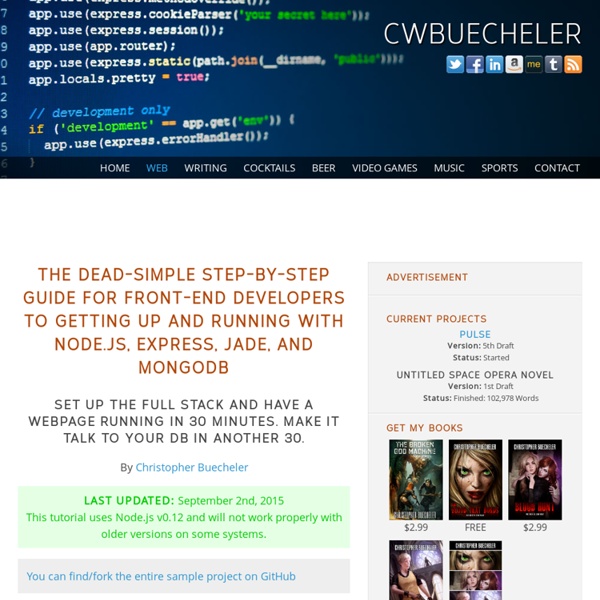



Node.js Language Center You use Node.js to write event-driven, scalable network programs in server-side JavaScript. Node.js runs on Google’s V8. This section describes the available tools and suggested practices for using Node.js with MongoDB. For a more detailed discussion, see the Node.js Driver Manual. The following are the README and source code: Node.js Driver The MongoDB Node.js driver is the officially supported node.js driver for MongoDB. Install or Upgrade The easiest way to install is to use npm: Object Mappers Because MongoDB is so easy to use, the basic Node.js driver can be the best solution for many applications. Other Notable Projects Mongoskin: Layer for node-mongodb-native.Mongolia: Lightweight MongoDB ORM/driver wrapper.Mongojs: Somewhat mimics the MongoDB shell api. Each of these projects build on top of the native Node.js driver, and so some knowledge of that is useful, especially if you work with a custom MongoDB configuration. 3rd Party Drivers A few 3rd party drivers exist.
Node.js and MongoDB - Getting started with MongoJS HEADS UP! This article was written for an older version of node. More up-to-date information may be available elsewhere. It won't be an exaggeration if one claims that in the past few months Node.js and MongoDB have literally taken the software and web industries by storm. Not just bleeding-edge startups but even medium and large enterprises are leveraging these two technologies to deliver a better experience to their users by build more capable, performant and scalable apps. So what is Node.js? Node.js is a platform built on Chrome's JavaScript runtime for easily building fast, scalable network applications. ..and what is MongoDB? MongoDB is a scalable, high-performance, open source NoSQL database. This post will cover the basics and get you started with your Node.js + MongoDB app. Let's verify your Node.js installation and start the MongoDB server: $ node -v$ mongod Introducing MongoJS Installing MongoJS $ npm install mongojs Okay, how do I save a new user in my collection? $ node app.js
Mac OS X packages PostgreSQL is the default database on Mac OS X Server as of version 10.7. The standard version of Mac OS X includes only the PostgreSQL commandline client utilities. Mac OS X Server 10.7 ships with PostgreSQL 9.0. There are several other installers available for PostgreSQL on Mac OS X, which is the recommended way to install. Graphical installer An installer is available for Mac OS X that includes PostgreSQL, pgAdmin and the StackBuilder utility for installation of additional packages. Download the installer from EnterpriseDB for all supported versions. Postgres.app Postgres.app is a simple, native Mac OS X app that runs in the menubar without the need of an installer. Fink PostgreSQL packages are available for Mac OS X from the Fink Project. A list of PostgreSQL packages can be found using the package search tool on the Fink website. MacPorts PostgreSQL packages are also available for Mac OS X from the MacPorts Project. Homebrew PostgreSQL can also be installed on Mac OS X using Homebrew.
Install MySQL on Mountain Lion. | Mac Mini Vault UPDATE 02/26/2013: You can skip all these steps and use the install script on our github [LINK] page to automate the installation of MySQL. Then just install a management program (Sequel Pro) and you are all set! UPDATE 10/9/2013: Be sure to check out our post on MySQL installation for OS X 10.9 Mavericks! ———— Last year when OS X 10.7 Lion was released we found ourselves with a version of OS X Server without MySQL and basic web hosting capabilities. Luckily by 10.7.3 most of the necessary web hosting functionality was added to Server.app. Today OS X 10.8 Mountain Lion was released and we are going to do a few write ups on how to install MySQL and do some basic CMS/Blog web hosting. dev.mysql.com/downloads/mysql Look for the DMG of the latest 64-bit version (10.6 will work)Note: If you visit this link from a Mac it will automatically select the OS X Platform. We need to do a few things from a command prompt. user@computer:$ vi .bash_profile export PATH=$PATH:/usr/local/mysql/bin
MySQL C API programming tutorial This is a C programming tutorial for the MySQL database. It covers the basics of MySQL programming with the C API. You may also consider to look at the MySQL tutorial on ZetCode. About MySQL database MySQL is a leading open source database management system. $ sudo apt-get install libmysqlclient-dev To be able to compile C examples, we need to install the MySQL C development libraries. This tutorial uses C99. MYSQL *con = mysql_init(NULL); In C99, we can mix declarations with code. First example Our first example will test one MySQL function call. The mysql_get_client_info() shows the MySQL client version. #include <my_global.h> #include <mysql.h> We include necessary header files. printf("MySQL client version: %s\n", mysql_get_client_info()); This code line outputs the version of the MySQL client. exit(0); We exit from the script. $ gcc version.c -o version `mysql_config --cflags --libs` Here is how we compile the code example. $ . Example output. Creating a database We check the return value. $ . $ .
All Things Mat - How to: C, XCode & MySQL